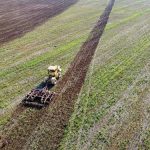Best Practices to Prepare Your Field for Winter
November 3, 2023 3:46 pm Leave your thoughts Winter is fast approaching, and for those who manage fields or outdoor spaces, now is the time to prepare for the colder months ahead. Proper winter preparation is essential to ensure the health and vitality of your field, and to minimize any potential damage caused by extreme weather conditions. In this blog post, we will discuss some best practices to help you effectively prepare your field for winter.
Winter is fast approaching, and for those who manage fields or outdoor spaces, now is the time to prepare for the colder months ahead. Proper winter preparation is essential to ensure the health and vitality of your field, and to minimize any potential damage caused by extreme weather conditions. In this blog post, we will discuss some best practices to help you effectively prepare your field for winter.
1. Conduct a thorough field assessment
Before undertaking any winter preparations, it is critical to assess the current condition of your field. Walk around the field, taking note of any existing damage, drainage issues, or areas that are particularly weak or vulnerable. This assessment will help you prioritize tasks and determine the necessary steps to prepare your field for winter.
2. Ensure proper drainage
Waterlogged fields are more susceptible to damage during winter due to freezing and thawing. Therefore, it is crucial to have a proper drainage system in place. Clear your field’s drainage channels, ditches, or catch basins from any debris or blockage that may impede the flow of water. If your field lacks appropriate drainage, consider consulting an expert who can suggest solutions tailored to your specific requirements.
3. Mow one final time and remove clippings
Before winter sets in, give your field one final mow, lowering the cutting height slightly. This helps prevent excessive thatch build-up and promotes air circulation. Additionally, remove all grass clippings and fallen leaves from the surface, as these can create a moist environment that encourages diseases and hinder proper growth during winter.
4. Aerate to relieve soil compaction
Compacted soil restricts root growth and prevents water absorption, which can be detrimental to the field’s overall health. Aerating the field with core aerators helps alleviate soil compaction by creating small holes that facilitate water and nutrient penetration. Pay particular attention to high traffic areas or regions that have been compacted by heavy machinery, ensuring thorough aeration to improve soil quality and alleviate compaction issues.
5. Overseed to promote growth
Overseeding your field with winter grass varieties is essential for maintaining green, healthy turf throughout the winter months. Choose a grass variety that is suitable for your climate and field conditions. Overseeding helps fill in any bare spots, improves tolerance to winter stress, and ensures your field can withstand the harsh conditions associated with winter.
6. Apply a winter fertilizer
As temperatures drop, your field’s nutrient needs change. Applying a winter fertilizer helps provide the necessary nutrients for root development and overall plant health during winter. Look for a fertilizer specifically formulated for winter application and follow the recommended dosage instructions to avoid over-fertilization. This will ensure your field enters the winter season with a robust nutrient reserve, enabling it to bounce back quickly in the spring.
7. Protect your field with covers
For areas that are prone to extreme cold or heavy snowfall, consider using protective covers to shield your field from harsh weather conditions. Covers help insulate the turf, providing added protection against cold damage and reducing the risk of disease development. Make sure to install covers properly, ensuring complete coverage and securely anchoring them to prevent wind uplift.
8. Prepare your equipment for winter storage
Lastly, don’t forget to properly store your equipment for winter to prolong their lifespan and prevent damage. Clean and lubricate all machinery thoroughly, removing any debris or grass clippings. Ensure all fuel tanks are empty to prevent fuel degradation and equipment damage. Lastly, store equipment in a dry and sheltered area to protect it from the elements.
Summary
Proactive winter preparation is vital to keep your field healthy, vibrant, and ready to tackle the challenges of the colder months. By assessing your field, improving drainage, mowing, aerating, overseeding, applying winter fertilizer, using protective covers, and properly storing equipment, you can ensure that your field is well-prepared for winter. Following these best practices will help safeguard your investment and set you up for success next spring.
Need Cotton Mill & Cotton Gin Components in Lubbock, TX?
Welcome to M.B. McKee Company, Inc. M.B. McKee Company, Inc. has been serving our local community of Lubbock since 1943. Locally owned and family operated, we provide great customer service and solutions for ongoing issues. With over 70 years of experience, our products, services, and engineering will always exceed your expectations. Our products include bearings, belts, chains, conveyor systems, gearing, lifts, motors, drives, product separation, tools, valves, and fittings. Our engineering division also provides general formulas, NEMA motor frames, elevator legs, screw and belt conveyors, lift charts, components from Baldor and Flexco, and various interchangeable parts. Contact us today to learn more about what we can do for you!
Categorised in: Crops
This post was written by admin

